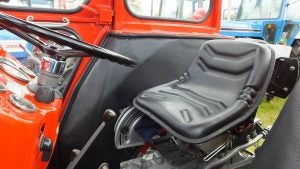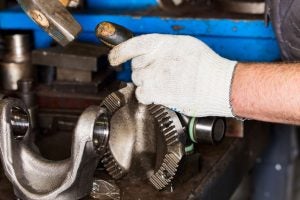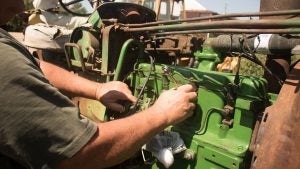Restoring a tractor is a labor of love, but there’s much that can be done to make the project move forward smoothly
It’s a dream project for many — restoring an old family tractor. Whether to take to shows, or perhaps just for old time’s sake, the tractor restoration process from start to finish can truly be a labor of love — but a labor for sure. And the most daunting element of the whole project may well be finding the necessary old tractor parts or even the right tractor paint or decals. But as any do-it-yourselfer knows, there’s a lot more to a project than just assembly, and bringing an old tractor back to life is no different.
Working on an old tractor is far different than pouring effort into a newer machine, and so special considerations must be taken when undergoing a tractor restoration project. We spoke with some of the industry’s experts about this task and what’s vital to getting everything together and finding tractor parts for the job.
Here are our five key takeaways from these tractor restoration discussions:

1. Get a Shop Manual
Before launching into a tractor restoration remodel project, one vital investment is the appropriate shop manual. Available for purchase online, the shop manuals come for nearly every make and model of tractor ever built, complete with diagrams, instructions, and part numbers. And it’s not just for the assembly. Once up and running, owners will want to keep their tractor well maintained. And it’s true what they say, they just don’t build them like they used to — meaning lubricants and other approaches might need to be adjusted.
2. Choose a Good Tractor Parts Supplier
Depending on the project, a remodeler might luck out and have a supplier just down the road. But if the tractor is any more than a couple decades old, the parts will probably be out of stock locally. The good news is that the digital age has brought online resources such Quality Farm Supply into the mix, which carries parts from makes and models spanning the agri-tractoverse.
Whether it’s finding the proprietary tractor paint to match the old brand or getting the right radiator hoses in hand, sourcing tractor parts is often the trickiest part of working on older models. Some online outfits even carry model-appropriate emblems and decals. Quality and appropriate accessories, too, are required for a project and should not be overlooked.

3. Work Out a Budget
Everyone knows tractor restoration and remodeling projects take longer and cost more than initially projected, but without a budget, it’s more likely than not the job will get lost into the background of farm tasks. But with Steps 1 and 2 complete, the remodeler now has a path to establishing a shopping list. Using the shop manual to guide your souring of tractor parts will give a fair estimate of the projected cost. For a large project, bulk purchases and other benefits can often be had from suppliers like Quality Farm Supply, which has more than 6,000 different tractor parts, covering Ford, Case IH, John Deere, Kubota, and more. (Plus, QFS customers can receive free standard shipping on orders over $200, so finding little ways like that to save money will help in the long run.)
Each project will have a completely different cost structure depending on parts and condition of the tractor, meaning proper planning will prevent potential problems. It’s one thing to restore a tractor that has set out in the woods for 20-plus years, where you may have to take torches out to cut apart the rods for unit disassembly and re-build, it’s another to bring new life to a machine that’s been sheltered its whole life.
4. Plan Out Time and Space Requirements
Parts suppliers and hobbyists alike agree: Restoring a tractor could take anywhere from 100 to 250 hours for the labor alone. Ordering parts may take a couple of days for delivery, but the actual assembly time is nothing to sneeze at. Planning to launch the project during the colder winter months might be a good idea, particularly if the remodeler is also an active farmer with busy planting schedules in the spring and summer and harvest in the fall.
The same kinds of considerations hold true for space. The body of a working tractor might require just a stall inside the barn, but imagine hundreds of tiny tractor parts scattered about. One trick of the trade is to use old vegetable cans for the various nuts, bolts, and other tiny parts that will all go into this unit one piece at a time. With a roll of duct tape at hand, one can write the name, number, and any other pertinent details on each can full of parts.
If the project is to take place inside a working garage, that’s great, but if it’s going to occur in a barn where livestock live, remember to secure all gates and protect the investment. Cats are great for keeping mice away from feed, but they’d love nothing more than to knock over a can of bolts and roll them around the floor.

5. Scout Out a Team
Yes, it’s a labor of love for sure, but restoring an old tractor might require more work than one person can handle. With Steps 1 through 4 completed, it won’t be nearly as hard a pitch to get some friends involved since they’ll know it’s not just a lark (the offer of free pizza doesn’t hurt, either). And friends can make all the difference between success and failure in tractor restoration. This is particularly true when installing engines and adjusting axles. Depending on the project, welders, hydraulic lifts, and other specialized tools might be required from time to time.
Back to Step 3, when factoring in a budget, make sure to judge just how many of these tools are really needed for purchase, which can be rented, and which simply require a phone call to a friend. Another couple of pairs of hands won’t hurt anyway when trying to screw into place all those moving parts.
Tractor Passion
There’s no question, tractors are cool, and every farm kid grew up checking out the old models and wanting to ride along. Whether a 1928 Farmall Regular, or a 1960s-era Ford Series 2000, failing to plan means planning to fail. Hopefully, these tractor restoration tips and advice on tractor paint and parts can go a long way to preventing that from occurring.
Brian Boyce is an award-winning writer living on a farm in west-central Indiana. You can see more of his work at www.boycegroupinc.com. This article was funded by and published on behalf of Quality Farm Supply.




